Hungarian identity card


In Hungary, one can have an ID after they were born, but it is not compulsory till 14 yrs old. Since 1 January 2006, it is possible for citizens of Hungary to travel anywhere within the Schengen Area, the European Union and some other European countries such as Macedonia[1] using only this card.
Currently, there are three types of valid identity documents (Személyi igazolvány, abbr. Sz.ig.): the oldest valid ones are hard-covered, multipaged book and issued before 1989 by the People's Republic of Hungary, the second type is a soft-cover, multipaged book issued after the democratic change of the state; these two have one, original photo of the owner embedded, with original signatures of the owner and the local police's representative. The third type is a plastic card (since 2000) with the photo and the signature of the holder digitally reproduced. These are generally called Personal Identity Card.
The plastic card shows the owners full name, maiden name if applicable, birth date and place, mother's name, sex and the ID's validity period and the local state authority which issued the card. The card has a 6 number + 2 letter unique Id. It does not have any information about the owners residual address, nor his/her Personal ID—this sensitive information is contained on a separate card, called Authority ID. The Personal ID has its roots in the Communist era: it has the following format in numbers: sex (1 number)-birthdate (6 numbers)-unique ID (4 numbers). It is no longer used as a personal identification number, but a statistical signature.
Other valid documents are the passport (blue colored or red colored with RFID chip) and the driver's license; an individual is required to have at least one of them on hand all the time. The Personal Identity Card is mandatory to vote in state elections or open a bank account in the country.
